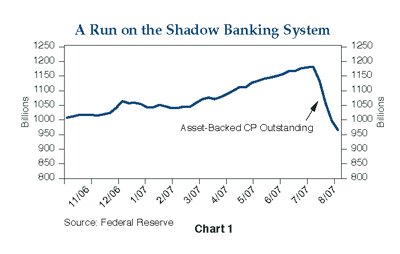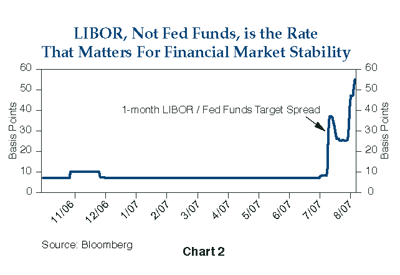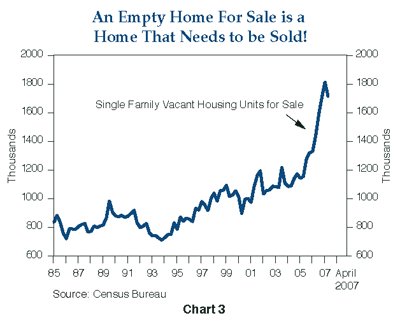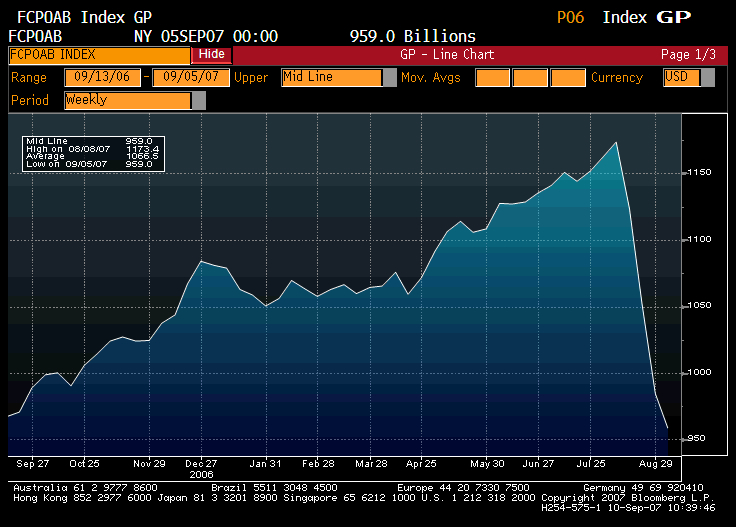Fed Expected to Cut Interest Rates As US Recession Looms
Interest-Rates / US Interest Rates Sep 10, 2007 - 07:47 PM GMTBy: John_Mauldin

 This week in Outside the Box, good friend Paul McCulley of PIMCO fame addresses the important topic of fed fund easing. Paul addresses the predicament the current Fed finds itself in on account of not wanting to bail out those who took excessive risk in what he dubs the "shadow banking system," - comprising an alphabet soup of levered non-bank investment conduits, vehicles, and structures. The crux of the matter as Paul highlights is that the 50bp discount rate reduction still remains a penalty to the Fed Funds rate, hence simply not an attractive source of funding for real banks, who have access to the Fed funds rate.
This week in Outside the Box, good friend Paul McCulley of PIMCO fame addresses the important topic of fed fund easing. Paul addresses the predicament the current Fed finds itself in on account of not wanting to bail out those who took excessive risk in what he dubs the "shadow banking system," - comprising an alphabet soup of levered non-bank investment conduits, vehicles, and structures. The crux of the matter as Paul highlights is that the 50bp discount rate reduction still remains a penalty to the Fed Funds rate, hence simply not an attractive source of funding for real banks, who have access to the Fed funds rate.
Bernanke and company are trying to kill the notion of a Fed Put, whereby the Fed "bails out" Wall Street whenever losses increase significantly which further worsens excessive risk taking, or moral hazard. The conclusion is while many would like to think this simply is a Wall Street quant fund predicament, the reality is that Main Street shares the pain in the form of tightening terms, conditions and rates for all but conforming mortgages. Thus, the Fed needs to reduce the Fed funds rate not to bail out Wall Street but rather to save Main Street from recession on account of weaker growth, which to boot would carry serious debt-deflation consequences. I have provided Chart I below in larger print for illustrative purposes.
John Mauldin
Editor, Outside the Box
Teton Reflections
Global Central Bank Focus
Paul McCulley | September 2007
There was only one topic at Jackson Hole that garnered enthusiastic, unanimous consensus: the Kansas City Federal Reserve Bank could not have picked a more important or more timely subject for its annual symposium - Housing, Housing Finance, and Monetary Policy.
KC Fed President Tom Hoenig and his colleagues, particularly Craig Hakkio, picked the topic back at the beginning of the year, before the sub-prime stuff hit the oscillator. Lucky? Maybe, but as a wise man once said, good luck tends to be a fellow traveler with hard work, and the good folks at the Kansas City Fed are eminently familiar with hard work.
On that, we all agreed. But regarding the subject at hand, there was much less of a consensus, not only to the right answers but at times, the right questions. But for the record, there were four official topics on the table:
- Just how bad is the recession in housing? Is it a popping bubble or merely a correcting of an over-priced asset class?
- Who should get the blame for the boom-bust cycle in housing?
- What should the Fed do to minimize the impact of the bust on both Wall Street and Main Street?
- What should be done to prevent similar boom-busts in the future, either in housing or other asset classes?
Each of these questions deserves an essay, but since I'm writing just one right now, I will focus on the third question: What should the Fed do?
The Shadow Comes Out of the Shadow
Not every house on every street corner in America experienced a bubble, all of us at Jackson Hole agreed. There was also consensus that such agreement added nothing to the discussion. The key question is whether enough of American homes on enough of America's street corners are suffering sufficient debt-deflation miseries to jeopardize either financial stability on Wall Street or sufficient spending to generate full employment on Main Street.
Make no mistake, there is a huge difference, at least in policy makers' minds, between those two negative consequences, despite the fact that they are functionally intertwined. Wall Street taking a financial bath on dud mortgages, dud structured products and dud leveraged buyouts, fueled by old fashioned greed smoking joints of hubris, is not, it was generally agreed, a bad thing. Indeed, it is a good thing. Capitalism works best when it crea-tively destructs the foolish levered momentum player, sending him to the poor house while his assets are sold at a deep discount to the less-levered (or even cash!) player.
In general, the Jackson Hole gang saw a lot of such creative destruction going on, and deemed it to be good. But they also worried about good thing going too far, with not just the foolish being taken out and shot, but the innocent, too. Technically, that's called systemic risk. And in the current circumstance, it's called a run on what I've dubbed the "shadow banking system" - the whole alphabet soup of levered up non-bank investment conduits, vehicles, and structures.
Unlike regulated real banks, who fund themselves with insured deposits, backstopped by access to the Fed's discount window, unregulated shadow banks fund themselves with un-insured commercial paper, which may or may not be backstopped by liquidity lines from real banks. Thus, the shadow banking system is particularly vulnerable to runs - commercial paper investors refusing to re-up when their paper matures, leaving the shadow banks with a liquidity crisis - a need to tap their back-up lines of credit with real banks and/or to liquidate assets at fire sale prices.
And make no mistake: that is precisely what has been happening in recent weeks, as evidenced both by a near $200 billion plunge in asset-backed commercial paper (see Chart 1) and soaring spreads between the Fed's Fed funds policy rate and LIBOR (see Chart 2). Indeed, LIBOR itself has widened sharply relative to the Fed's Fed funds policy rate, further straining the financial health of all borrowers - not just shadow banks - that borrow at a spread to LIBOR.


This problem was frequently referred to at Jackson Hole as the Fed's "plumbing problem," meaning that the basic plumbing of the financial system is clogged up, despite very hefty Fed injections of excess reserves, as those injections get stopped up in the real banking system, which is reluctant to lend them on to the shadow banking system. This plumbing problem was precisely the rationale for the Fed's 50 basis point cut in the discount rate on August 17, along with liberalized tenors for discount window borrowers.
A (So Far) Impotent Roto Rooter
I certainly applauded the Fed's actions that day, thinking they might help unclog the plumbing and at worst do no harm, similar to the bowl of chicken noodle soup my mother insisted I eat when I had a cold as a youngster. But the fact of the matter is that these actions are not effectively roto rootering the plumbing - getting Fed-created liquidity from its discount window to the shadow banking system. There are three, interrelated reasons, I suggest:
- The discount rate remains a 50 basis point penalty rate to the Fed funds rate, so it is simply not an attractive source of funding for real banks, who have access to the Fed funds market.
- Despite a change in the discount window regime back in 2003 - changing the discount rate from a subsidized rate to the Fed funds rate for those who had exhausted all other funding sources to a penalty rate with no need for users to demonstrate that all other sources of liquidity had been exhausted - there remains a taint or stigma associated with using the window. Shouldn't be, as Fed officials have said repeatedly, but reality is reality: nobody that is weak wants to be seen at the window and anybody who is strong has no need, given that the discount rate is a penalty rate. As a practical matter, beyond for-show borrowings by strong banks, the discount window only services to put a cap on the LIBOR-Fed funds rate spread - equal to the amount of the penalty.
- Despite being flush with Fed supplied liquidity and access to more at the discount window at a 50 basis point penalty, real banks are in a risk averse state of mind when it comes to lending to shadow banks, lending when required by back-up lines but not seeking to proactively increase their footings to the shadow banking system but, if anything, reduce them. Thus, there is a mighty gulf between the Fed's liquidity cup and the shadow banking system's parched liquidity lips.
Re-Striking The Put
The Fed knows these limitations to the efficacy of the discount window in unclogging the financial system plumbing. The Fed also knows that part of the problem, besides the mechanics laid out above, is that risk aversion in the financial system has not historically been broken except by cuts in its Fed funds policy rate. Yes, the Fed does know this. But the Fed has refused to cut the Fed funds rate so far, because the Fed also knows that this history supports the notion of a Fed Put, whereby the Fed "bails out" Wall Street whenever Wall Street losses soar, giving birth to excessive risk taking, also known as moral hazard.
And right now, particularly under new Fed Chairman Bernanke, policy makers want to disabuse the markets of any notion of a free Fed Put for the foolish levered risk taker. As both a theoretical and practical matter, it is hard to argue with that proposition. In capitalist financial markets, discipline and prudence require that investors fear - yes, fear - that they can lose; and lose big time. Nonetheless, there can be no denying that a Fed Put does exist; indeed, that was the primary reason the Fed was created in 1913, to provide an "elastic currency" so as to truncate cycles of panic that predated its creation. The question is not whether the Fed Put exists, but where is its strike price?
Under the Bernanke Fed, the goal, which I applaud, is to change consensus expectations about the location of the strike price: further, much further out of the money than under the Greenspan Fed. And the way to do that is to emphasize discount window operations - however practically ineffective - as the primary tool for dealing with financial instability, while emphasizing that the big gun of cuts in the Fed funds rate is reserved for achieving the Fed's Main Street objective of sufficient demand growth to generate full employment with low and stable inflation.
Bottom Line
There is a connection between Wall Street's woes and cuts in the Fed funds rate, but the connection is through the impact of Wall Street tightening of credit provision to Main Street, opening downside risk to Main Street growth, not losses on Wall Street per se . Put differently, if the Wall Street tree fell but nobody on Main Street heard it, the Fed wouldn't give a hoot. But, of course, that isn't realistic and the Fed knows it.
Wall Street's falling tree is being heard very loudly on Main Street in the form of tightening terms, conditions and rates for all but conforming mortgages. And this tree is falling in the middle of a forest of homes for sale, many unoccupied, a sure sign of preceding speculative activity (see Chart 3).

Thus, the Fed needs to ease and will ease, substantially I firmly believe, not to bail out Wall Street but to make certain that weaker growth on Main Street does not morph into recession, which would carry serious debt-deflation consequences. It's a risk management world: recession may be a low risk (though not as low as only a few months ago), but the consequences would be very severe. It's a fat macroeconomic tail that the Fed must, and will, cut off.
And that's a much bigger, and more important, job than running a roto rooter snake through the financial system's plumbing. Here's saying a prayer that 100 basis points of Fed funds cuts, by the end of 2007, will not be too late for the sky.
Paul McCulley
Managing Director
Your anticipating a fed funds rate reduction analyst,
By John Mauldin
http://www.investorsinsight.com
To subscribe to John Mauldin's E-Letter please click here: http://www.frontlinethoughts.com/subscribe.asp
Copyright 2007 John Mauldin. All Rights Reserved
John Mauldin is president of Millennium Wave Advisors, LLC, a registered investment advisor. All material presented herein is believed to be reliable but we cannot attest to its accuracy. Investment recommendations may change and readers are urged to check with their investment counselors before making any investment decisions. Opinions expressed in these reports may change without prior notice. John Mauldin and/or the staff at Millennium Wave Advisors, LLC may or may not have investments in any funds cited above. Mauldin can be reached at 800-829-7273.
Disclaimer PAST RESULTS ARE NOT INDICATIVE OF FUTURE RESULTS. THERE IS RISK OF LOSS AS WELL AS THE OPPORTUNITY FOR GAIN WHEN INVESTING IN MANAGED FUNDS. WHEN CONSIDERING ALTERNATIVE INVESTMENTS, INCLUDING HEDGE FUNDS, YOU SHOULD CONSIDER VARIOUS RISKS INCLUDING THE FACT THAT SOME PRODUCTS: OFTEN ENGAGE IN LEVERAGING AND OTHER SPECULATIVE INVESTMENT PRACTICES THAT MAY INCREASE THE RISK OF INVESTMENT LOSS, CAN BE ILLIQUID, ARE NOT REQUIRED TO PROVIDE PERIODIC PRICING OR VALUATION INFORMATION TO INVESTORS, MAY INVOLVE COMPLEX TAX STRUCTURES AND DELAYS IN DISTRIBUTING IMPORTANT TAX INFORMATION, ARE NOT SUBJECT TO THE SAME REGULATORY REQUIREMENTS AS MUTUAL FUNDS, OFTEN CHARGE HIGH FEES, AND IN MANY CASES THE UNDERLYING INVESTMENTS ARE NOT TRANSPARENT AND ARE KNOWN ONLY TO THE INVESTMENT MANAGER.
John Mauldin Archive |
© 2005-2022 http://www.MarketOracle.co.uk - The Market Oracle is a FREE Daily Financial Markets Analysis & Forecasting online publication.
Comments
|
John Ryskamp
10 Sep 07, 20:15 |
Cut interest rates?
Your reasoning for the rate cut makes no sense to me. It will make banks less, not more, willing to lend. Libor will go up, CDX will go up. |



